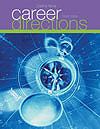|
 |  Career Directions, 4/e Donna J. Yena,
Johnson & Wales University
Table of ContentsPart One: Career Planning- Chapter 1: The Millennial Workplace
- World Trends and Tomorrow's Workplace
- American Responses to Millennial Workplace Challenges
- Success in the Millennial Workplace: Skills-Based and Lifelong Learning
- Chapter 2: Self Assessment
- Understanding Yourself
- Defining Success
- Employer Expectations
- Setting Goals for Self-Improvement
- Proof by Example--How You Add Value to an Employer
- Chapter 3: Personal Development
- Communication Skills
- The Sales Process
- Business Protocol
- Awareness of the World Around You
- Personal Care and Personal Appearance
- Time and Stress Management
- Role Models
- Chapter 4: Career Paths Overview
- Job Versus Career
- Career Phases
- Career Trends
- Where the Jobs Are
- Chapter 5: Your Career Portfolio
- Build Skills Employers Value
- Identify Opportunities to Build Skills
- Refining Your Plan
- Develop Your Career Portfolio
- Planning Your Portfolio Presentation
Part Two: Job Search Techniques- Chapter 6: Sources of Job Information
- The Nature of Today's Job Market
- The Visible Job Market
- The Hidden Job Market
- The Very Hidden Job Market
- Chapter 7: Résumés and Job Applications
- Résumés
- Traditional Résumés
- Writing Your Own Résumé
- Nontraditional Résumés
- Job Applications
- Chapter 8: Letters
- Guidelines for Writing Job Search Letters
- Letters You May Write During Your Job Search
- Chapter 9: Successful Interviews
- Securing a Job Interview
- Types of Interviews
- Preparing for a Job Interview
- Conducting a Successful Interview
- After the Interview
- The Interview Hall of Fame and Shame
- Chapter 10: Accepting or Rejecting a Job
- What You Offer the Employer
- What the Employer Offers You
- Cost of Living and Budgeting
- Accepting the Right Job
- Chapter 11: Dealing with Rejection
- Playing to Win
- Factors That Most Often Lead to Rejection
- What You Can and Cannot Control
- Cutting Your Losses
Part Three: Career Management- Chapter 12: Your First Months on the Job
- Before Arrival on the Job
- Your First Day
- Orientation and Training Programs
- Probationary Periods (One to Three Months)
- Periodic Review and Assessments
- Chapter 13: Growing With Your Job
- Building Professional Relationships
- Improving Your Effectiveness
- Promotions
- Recession-Proofing Your Job
- Successful Career Moves
- Chapter 14: Contemporary Issues in the Workplace
- Health-Related Issues
- Family Care Issues
- Ethics
- Career Handbook
Section A: Career Paths- How to Use “Career Paths”
- Accounting
- Business Administration
- Court Reporting and Related Careers
- Criminal Justice
- Fashion & Retail Management
- Financial Services
- Healthcare
- Hospitality
- Rooms Division
- Food Service
- Sports, Recreation, Entertainment & Events
- Travel Tourism
- International Business
- Marketing
- Office Management
- Technology
- Telecommunications
Section B: Glossary of TermsSection C: Index of Job DescriptionsSection D: Career ResourcesSection E: BibliographyIndex |
|
|



 2007 McGraw-Hill Higher Education
2007 McGraw-Hill Higher Education

 2007 McGraw-Hill Higher Education
2007 McGraw-Hill Higher Education